Richard Lund (1885–1960) was a Swedish film and theatre actor, who had a prolific career in the films of Victor Sjöström and Mauritz Stiller. He starred in such Swedish silent films as Herr Arnes pengar/Sir Arne's Treasure (Mauritz Stiller, 1919).
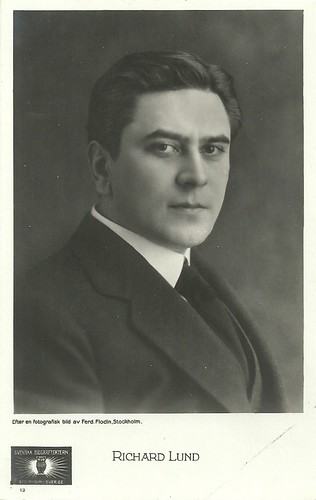
Swedish postcard by Svenska Biografteatern, no. 12. Photo: Ferd. Flodin, Stockholm.
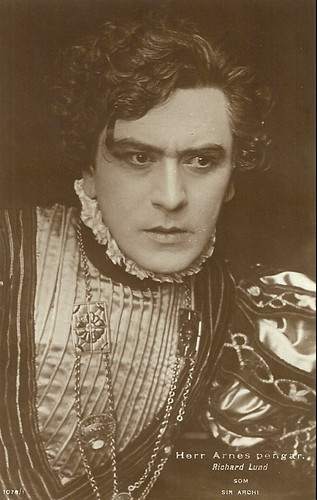
Swedish postcard by Förlag Nordisk Konst, Stockholm, no 1078/1. Richard Lund as Sir Archi(e) in Herr Arnes pengar/Sir Arne's Treasure (Mauritz Stiller, 1919).
Richard Lund was born in Göteborg (Gothenburg), Sweden, in 1885. He made his stage debut at the Stora Teatern (The Old Theatre) in Göteborg in 1904. He later came to work in ensembles under such varied theatre directors as Hjalmar Selander, Ivan Hedqvist and Karl Gerhard. In 1909 he played in a stage adaptation of Maurice Leblanc’s Arsène Lupin at the Stockholm Oscarteatern.
In 1912 Lund began his – long-lasting - career as a film actor and would appear in 73 films between 1912 and 1952. He played his most important roles during the silent film era. He debuted at the company Svenska Biografteatern in Victor Sjöström’s film Ett hemligt giftermål eller Bekännelsen på dödsbädden/A Secret Marriage or Confession on His Deathbed (1912), distributed in the US as A Ruined Life, and with Hilda Borgström in the female lead. The film also was the debut of actress Greta Almroth.
Lund became a regular at Svenska Bio, often cast as the young, handsome love interest. In 1913 he acted in Mauritz Stiller’s smuggler’s drama På livets ödesvägar/The Smugglers/ The Fisherman’s Son (1913) with the Danish actors Carlo and Clara Wieth. It was followed by a series of films by Victor Sjöström: Löjen och tårar/Laughter and Tears (1913), Livets konflikter/The Conflicts of Life (1913), Lady Marions sommarflirt/Lady Marion's Summer Flirtation (1913), and Ingeborg Holm (1913). Apart from Löjen och tårar, Hilda Borgström was his co-star in all these films.
Mauritz Stiller directed Richard Lund in the films Gränsfolken/Brother against Brother (1913) and Den moderna suffragetten/The Modern Suffragette (1913). Then followed Blodets röst/The Voice of Passion (Victor Sjöström, 1913) with Sjöström himself in the lead.
While many of these films are lost, Ingeborg Holm (Victor Sjöström, 1913) remains and shows the troubles of a grocer’s widow (Hilda Borgström) who falls down the social ladder and is forced to move to the poor house where her children are taken from her. Lund plays the doctor at the poor house. With its social critique, it was the first film in Sweden - and possibly globally - that influenced the public debate and brought about changes. It is also remarkable for its restrained performance and sophisticated staging.
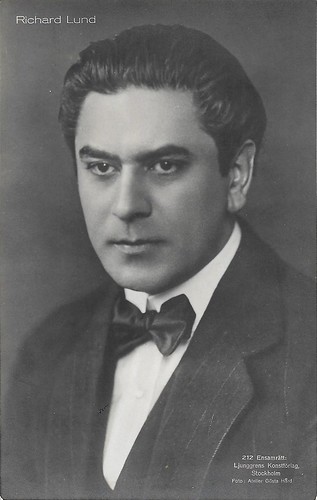
Swedish postcard by Ljunggrens Konstförlag, Stockholm, no. 212. Photo: Atelier Gösta Hard.
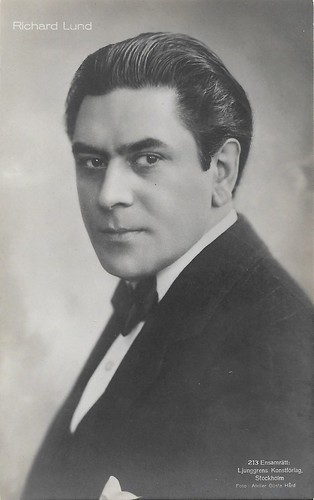
Swedish postcard by Ljunggrens Konstförlag, Stockholm, no. 213. Photo: Atelier Gösta Hard.
In 1914, Richard Lund’s career at Svenska Bio was confirmed in 1914 with Stormfågeln/Stormy Petrel (Mauritz Stiller, 1914) starring Lilli Bech (or Beck), and För sin kärleks skull/Because of Her Love (1914) with Lilli Bech and Victor Sjöström.
That year, he also appeared in five films by Victor Sjöström: Prästen/The Clergyman (1914) with Egil Eide and Clara Wieth, Kärlek starkare än hat eller Skogsdotterns hemlighet/The Poacher (1914) with John Ekman, Hjärtan som mötas/Hearts That Meet (1914) with Alfred Lundberg and Karin Molander, Dömen icke/Judge Not (1914) with Nils Arehn and Hilda Borgström, and Bra flicka reder sig själv/A Good Girl Keeps Herself in Good Order (1914) with Clara Wieth.
In 1915, ten new films followed. Lund made again five films with Sjöström: Strejken/The Strike (1915), Skomakare, bliv vid din läst/Stick to Your Last, Shoemaker (1915), Landshövdingens döttrar/The Governor's Daughters (1915), I prövningens stund/In the Hour of Trial (1915), and Det var i maj/It Was in May (1915). He also made four films with Mauritz Stiller: Lekkamraterna/Playmates (1915), Hämnaren/The Avenger (1915), Hans hustrus förflutna/His Wife's Past (1915), Hans bröllopsnatt/His Wedding Night (1915). He also appeared in Hans faders brott/His Father's Crime (Fritz Magnussen, 1915).
From 1916, the number of films in which Lund played went down but some of his most memorable film titles date from the late 1910s and early 1920s. In 1916, he played in Lyckonålen/The Lucky Brooch (Mauritz Stiller, 1916), Kärlek och journalistik/Love and Journalism (Mauritz Stiller, 1916), Kampen om hans hjärta/The Fight for His Heart (Mauritz Stiller, 1916) and Havsgamar/Predators of the Sea (Victor Sjöström, 1916).
Lund also acted Balettprimadonnan/Anjala the Dancer (Mauritz Stiller, 1916) opposite the debuting Jenny Hasselqvist and rising star Lars Hanson, who had debuted in 1915. The film deals with a violin player (Hanson) who discovers a peasant girl (Hasselqvist) and promotes her as a dancer but a scheming count (Lund) separates the two by offering the violin player training abroad. Balettprimadonnan was an international success and was distributed all over the world. Two copies of the film sent by ship to England disappeared when the ship was torpedoed and sunk in the autumn of 1917. The film was long considered lost, but in 1995 an incomplete copy of the film was found in Zaragoza in Spain and restored and reconstructed, using still images and copyright information.
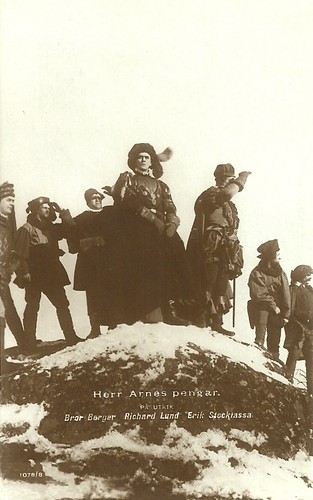
Swedish postcard by Nordisk Konst, Stockholm, no. 1078/8. Richard Lund, Bror Berger and Erik Stocklassa in Herr Arnes pengar/Sir Arne's Treasure (Mauritz Stiller, 1919). Caption: On the Lookout.
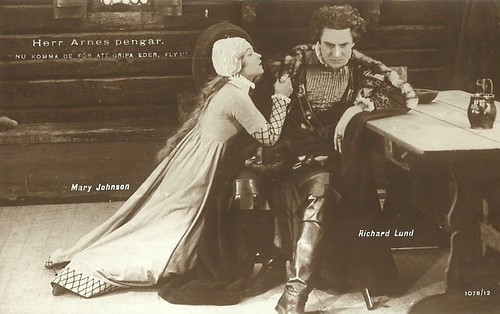
Swedish postcard by Nordisk Konst, Stockholm, no. 1078/12. Richard Lund and Mary Johnson in the Swedish silent film Herr Arnes pengar/Sir Arne's Treasure (Mauritz Stiller, 1919). Caption: They have come now to arrest you, escape!
In 1917, Richard Lund did not act in any films by Stiller nor Sjöström, but instead in two by Fritz Magnussen, one by Egil Eide (who had become director) and two by Konrad Tallroth. No films with Lund were released in 1918.
In 1919, Lund appeared in his best-known film role, that of Sir Archie in Herr Arnes pengar/Sir Arne's Treasure (Mauritz Stiller, 1919). In this crime-drama based on Selma Lagerlöf’s novel 'The Treasure', and set on the Swedish coast in the 16th century, Lund is a Scottish mercenary who, together with his cronies Sir Donald (Bro Berger) and Sir Filip (Erich Stocklassa), has escaped from a Scottish prison and fled to Sweden. There, he murders the family of Sir Arne to obtain a treasure, after which he unknowingly starts an affair with the daughter of the murdered family, Elsalill (Mary Johnson).
Sir Arne’s Treasure still goes as one of - if not the - masterpiece(s) of the Swedish silent cinema. Jerzy Toeplitz wrote in his 'Geschichte des Films' (1972): “As with Sjöström, Nature plays a leading role in Stiller's film. Already in the first images, the snow creates the atmosphere of the action. In the tragic finale, the sea becomes a contributor. In the small port of Marstrand lies the ship that should return the Scots to their home. But it is wedged by ice floes.
When the situation is strained to the utmost because the forces of nature cannot be conquered, in the city the news spreads that the criminals want to flee. In the battle with the town guards, Elsalill dies and Sir John Archie is captured. A long train of grey-clad women arrives at the ship to take off the corpse of Elsalill, after which the ice bursts and the occupied ship begins to move. Too late the silent, dangerous sea shows up.”
Next, Lund acted as the antagonist in Klostret i Sendomir/The Monastery of Sendomir (Victor Sjöström, 1920), based on an 1828 short story by Franz Grillparzer. It deals with a monk (Tore Svennberg) who tells two visitors how the convent was built by a repentant count who killed his unfaithful and treacherous wife (Tora Teje) after he had discovered she had a long-standing affair with her cousin Oleg (Richard Lund) and even his child was not his own. The monk proves to be the count himself. In Germany a competing version was made in 1919 by Union, starring Ellen Richter and Eduard von Winterstein, and causing a fierce battle over the release of the two films in Sweden.

Swedish postcard by Förlag Nordisk Konst, Stockholm, no. 1092/6. Photo: publicity still for Klostret i Sendomir/The Monastery of Sendomir (Victor Sjöström, 1920) with Tora Teje and Richard Lund.
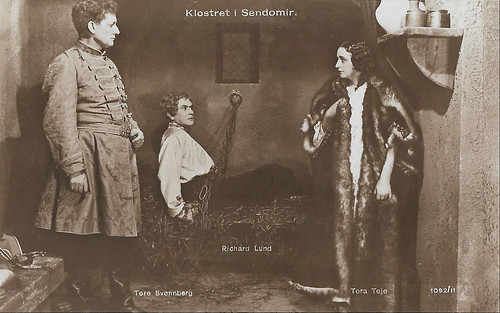
Swedish postcard by Förlag Nordisk Konst, Stockholm, no. 1092/11. Photo: publicity still for Klostret i Sendomir/The Monastery of Sendomir (Victor Sjöström, 1920) with Tore Svennberg, Richard Lund and Tora Teje.
Richard Lund’s following film was Carolina Rediviva (Ivan Hedqvist, 1920), a film set in the Uppsala university world, in which Renée Björling plays a foundling, whose mother Lina has left her at the university gate, to be adopted by students, and whose identity once revealed causes scandal in the academic world. Lund is Björling’s love interest.
In Det omringade huset/The Surrounded House (Victor Sjöström, 1922). Lund was the brother of the leading character Mary (Meggie Albanesi), while co-actors were Victor Sjöström, Uno Henning and Ivan Hedqvist. Lund’s last silent films were Livet på landet/Life in the Country (Ivan Hedqvist, 1924), Farbror Frans/Uncle Frans (Sigurd Wallén, 1926), and Dollarmillionen (Sigurd Wallén, 1926).
Lund easily made the passage to Swedish sound cinema, starting with Konstgjorda Svensson (Gustaf Edgren, 1929), although that was a part-talkie. Lund also had a major part in Hjärtats röst (Rune Carlsen, 1930), shot at Les Studios Paramount outside Paris, and based on Alden Arthur Knipes’ novel 'Sarah and Son', which had been filmed in the US under its original title in 1930 by Dorothy Arzner.
However, in the 1930s Lund’s prime was past and his parts became smaller as in Valborgsmässoafton/Walpurgis Night (Gustav Edgren 1935), starring Lars Hanson, Victor Sjöström and a young Ingrid Bergman. Until 1952 Lund continued to act in small parts, even uncredited, in Swedish sound films, all in all, some 35 films from 1930 onwards.
Still, it was clear Richard Lund had peaked in the silent era of the 1910s and early 1920s. Lund died in Mölndal in 1960.
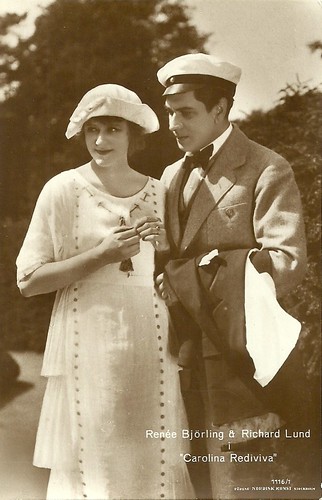
Swedish postcard by Nordisk Konst, Stockholm, no. 1116/1. Photo: publicity still of Renée Björling and Richard Lund in Carolina Rediviva (1920), directed by Ivan Hedqvist, who also played one of the leads.
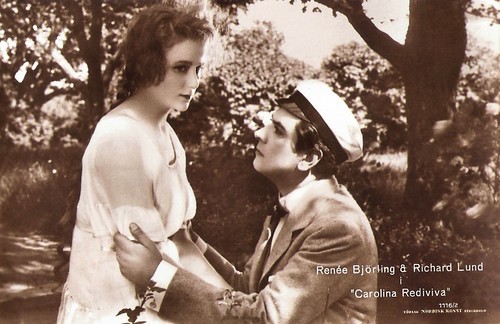
Swedish postcard by Nordisk Konst, Stockholm, no. 1116/2. Photo: publicity still for Carolina Rediviva (Ivan Hedqvist, 1920) with Renée Björling and Richard Lund.
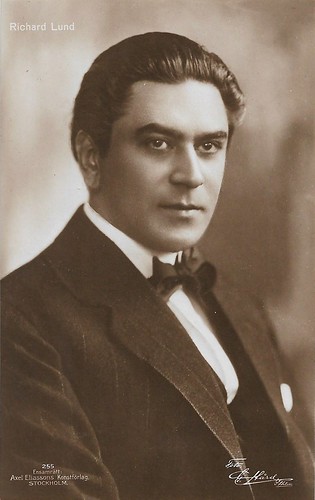
Swedish postcard by Axel Eliassons Konstförlag, Stockholm, no. 255. Photo: Gösta Hard.
Sources: The Swedish Film database, Wikipedia (Swedish and English), and IMDb.
This post was last updated on 9 April 2025.

Swedish postcard by Svenska Biografteatern, no. 12. Photo: Ferd. Flodin, Stockholm.

Swedish postcard by Förlag Nordisk Konst, Stockholm, no 1078/1. Richard Lund as Sir Archi(e) in Herr Arnes pengar/Sir Arne's Treasure (Mauritz Stiller, 1919).
The first film that influenced the public debate
Richard Lund was born in Göteborg (Gothenburg), Sweden, in 1885. He made his stage debut at the Stora Teatern (The Old Theatre) in Göteborg in 1904. He later came to work in ensembles under such varied theatre directors as Hjalmar Selander, Ivan Hedqvist and Karl Gerhard. In 1909 he played in a stage adaptation of Maurice Leblanc’s Arsène Lupin at the Stockholm Oscarteatern.
In 1912 Lund began his – long-lasting - career as a film actor and would appear in 73 films between 1912 and 1952. He played his most important roles during the silent film era. He debuted at the company Svenska Biografteatern in Victor Sjöström’s film Ett hemligt giftermål eller Bekännelsen på dödsbädden/A Secret Marriage or Confession on His Deathbed (1912), distributed in the US as A Ruined Life, and with Hilda Borgström in the female lead. The film also was the debut of actress Greta Almroth.
Lund became a regular at Svenska Bio, often cast as the young, handsome love interest. In 1913 he acted in Mauritz Stiller’s smuggler’s drama På livets ödesvägar/The Smugglers/ The Fisherman’s Son (1913) with the Danish actors Carlo and Clara Wieth. It was followed by a series of films by Victor Sjöström: Löjen och tårar/Laughter and Tears (1913), Livets konflikter/The Conflicts of Life (1913), Lady Marions sommarflirt/Lady Marion's Summer Flirtation (1913), and Ingeborg Holm (1913). Apart from Löjen och tårar, Hilda Borgström was his co-star in all these films.
Mauritz Stiller directed Richard Lund in the films Gränsfolken/Brother against Brother (1913) and Den moderna suffragetten/The Modern Suffragette (1913). Then followed Blodets röst/The Voice of Passion (Victor Sjöström, 1913) with Sjöström himself in the lead.
While many of these films are lost, Ingeborg Holm (Victor Sjöström, 1913) remains and shows the troubles of a grocer’s widow (Hilda Borgström) who falls down the social ladder and is forced to move to the poor house where her children are taken from her. Lund plays the doctor at the poor house. With its social critique, it was the first film in Sweden - and possibly globally - that influenced the public debate and brought about changes. It is also remarkable for its restrained performance and sophisticated staging.

Swedish postcard by Ljunggrens Konstförlag, Stockholm, no. 212. Photo: Atelier Gösta Hard.

Swedish postcard by Ljunggrens Konstförlag, Stockholm, no. 213. Photo: Atelier Gösta Hard.
An incomplete copy, found in Zaragoza
In 1914, Richard Lund’s career at Svenska Bio was confirmed in 1914 with Stormfågeln/Stormy Petrel (Mauritz Stiller, 1914) starring Lilli Bech (or Beck), and För sin kärleks skull/Because of Her Love (1914) with Lilli Bech and Victor Sjöström.
That year, he also appeared in five films by Victor Sjöström: Prästen/The Clergyman (1914) with Egil Eide and Clara Wieth, Kärlek starkare än hat eller Skogsdotterns hemlighet/The Poacher (1914) with John Ekman, Hjärtan som mötas/Hearts That Meet (1914) with Alfred Lundberg and Karin Molander, Dömen icke/Judge Not (1914) with Nils Arehn and Hilda Borgström, and Bra flicka reder sig själv/A Good Girl Keeps Herself in Good Order (1914) with Clara Wieth.
In 1915, ten new films followed. Lund made again five films with Sjöström: Strejken/The Strike (1915), Skomakare, bliv vid din läst/Stick to Your Last, Shoemaker (1915), Landshövdingens döttrar/The Governor's Daughters (1915), I prövningens stund/In the Hour of Trial (1915), and Det var i maj/It Was in May (1915). He also made four films with Mauritz Stiller: Lekkamraterna/Playmates (1915), Hämnaren/The Avenger (1915), Hans hustrus förflutna/His Wife's Past (1915), Hans bröllopsnatt/His Wedding Night (1915). He also appeared in Hans faders brott/His Father's Crime (Fritz Magnussen, 1915).
From 1916, the number of films in which Lund played went down but some of his most memorable film titles date from the late 1910s and early 1920s. In 1916, he played in Lyckonålen/The Lucky Brooch (Mauritz Stiller, 1916), Kärlek och journalistik/Love and Journalism (Mauritz Stiller, 1916), Kampen om hans hjärta/The Fight for His Heart (Mauritz Stiller, 1916) and Havsgamar/Predators of the Sea (Victor Sjöström, 1916).
Lund also acted Balettprimadonnan/Anjala the Dancer (Mauritz Stiller, 1916) opposite the debuting Jenny Hasselqvist and rising star Lars Hanson, who had debuted in 1915. The film deals with a violin player (Hanson) who discovers a peasant girl (Hasselqvist) and promotes her as a dancer but a scheming count (Lund) separates the two by offering the violin player training abroad. Balettprimadonnan was an international success and was distributed all over the world. Two copies of the film sent by ship to England disappeared when the ship was torpedoed and sunk in the autumn of 1917. The film was long considered lost, but in 1995 an incomplete copy of the film was found in Zaragoza in Spain and restored and reconstructed, using still images and copyright information.

Swedish postcard by Nordisk Konst, Stockholm, no. 1078/8. Richard Lund, Bror Berger and Erik Stocklassa in Herr Arnes pengar/Sir Arne's Treasure (Mauritz Stiller, 1919). Caption: On the Lookout.

Swedish postcard by Nordisk Konst, Stockholm, no. 1078/12. Richard Lund and Mary Johnson in the Swedish silent film Herr Arnes pengar/Sir Arne's Treasure (Mauritz Stiller, 1919). Caption: They have come now to arrest you, escape!
The masterpiece of the Swedish silent cinema
In 1917, Richard Lund did not act in any films by Stiller nor Sjöström, but instead in two by Fritz Magnussen, one by Egil Eide (who had become director) and two by Konrad Tallroth. No films with Lund were released in 1918.
In 1919, Lund appeared in his best-known film role, that of Sir Archie in Herr Arnes pengar/Sir Arne's Treasure (Mauritz Stiller, 1919). In this crime-drama based on Selma Lagerlöf’s novel 'The Treasure', and set on the Swedish coast in the 16th century, Lund is a Scottish mercenary who, together with his cronies Sir Donald (Bro Berger) and Sir Filip (Erich Stocklassa), has escaped from a Scottish prison and fled to Sweden. There, he murders the family of Sir Arne to obtain a treasure, after which he unknowingly starts an affair with the daughter of the murdered family, Elsalill (Mary Johnson).
Sir Arne’s Treasure still goes as one of - if not the - masterpiece(s) of the Swedish silent cinema. Jerzy Toeplitz wrote in his 'Geschichte des Films' (1972): “As with Sjöström, Nature plays a leading role in Stiller's film. Already in the first images, the snow creates the atmosphere of the action. In the tragic finale, the sea becomes a contributor. In the small port of Marstrand lies the ship that should return the Scots to their home. But it is wedged by ice floes.
When the situation is strained to the utmost because the forces of nature cannot be conquered, in the city the news spreads that the criminals want to flee. In the battle with the town guards, Elsalill dies and Sir John Archie is captured. A long train of grey-clad women arrives at the ship to take off the corpse of Elsalill, after which the ice bursts and the occupied ship begins to move. Too late the silent, dangerous sea shows up.”
Next, Lund acted as the antagonist in Klostret i Sendomir/The Monastery of Sendomir (Victor Sjöström, 1920), based on an 1828 short story by Franz Grillparzer. It deals with a monk (Tore Svennberg) who tells two visitors how the convent was built by a repentant count who killed his unfaithful and treacherous wife (Tora Teje) after he had discovered she had a long-standing affair with her cousin Oleg (Richard Lund) and even his child was not his own. The monk proves to be the count himself. In Germany a competing version was made in 1919 by Union, starring Ellen Richter and Eduard von Winterstein, and causing a fierce battle over the release of the two films in Sweden.

Swedish postcard by Förlag Nordisk Konst, Stockholm, no. 1092/6. Photo: publicity still for Klostret i Sendomir/The Monastery of Sendomir (Victor Sjöström, 1920) with Tora Teje and Richard Lund.

Swedish postcard by Förlag Nordisk Konst, Stockholm, no. 1092/11. Photo: publicity still for Klostret i Sendomir/The Monastery of Sendomir (Victor Sjöström, 1920) with Tore Svennberg, Richard Lund and Tora Teje.
A foundling left at the university gate
Richard Lund’s following film was Carolina Rediviva (Ivan Hedqvist, 1920), a film set in the Uppsala university world, in which Renée Björling plays a foundling, whose mother Lina has left her at the university gate, to be adopted by students, and whose identity once revealed causes scandal in the academic world. Lund is Björling’s love interest.
In Det omringade huset/The Surrounded House (Victor Sjöström, 1922). Lund was the brother of the leading character Mary (Meggie Albanesi), while co-actors were Victor Sjöström, Uno Henning and Ivan Hedqvist. Lund’s last silent films were Livet på landet/Life in the Country (Ivan Hedqvist, 1924), Farbror Frans/Uncle Frans (Sigurd Wallén, 1926), and Dollarmillionen (Sigurd Wallén, 1926).
Lund easily made the passage to Swedish sound cinema, starting with Konstgjorda Svensson (Gustaf Edgren, 1929), although that was a part-talkie. Lund also had a major part in Hjärtats röst (Rune Carlsen, 1930), shot at Les Studios Paramount outside Paris, and based on Alden Arthur Knipes’ novel 'Sarah and Son', which had been filmed in the US under its original title in 1930 by Dorothy Arzner.
However, in the 1930s Lund’s prime was past and his parts became smaller as in Valborgsmässoafton/Walpurgis Night (Gustav Edgren 1935), starring Lars Hanson, Victor Sjöström and a young Ingrid Bergman. Until 1952 Lund continued to act in small parts, even uncredited, in Swedish sound films, all in all, some 35 films from 1930 onwards.
Still, it was clear Richard Lund had peaked in the silent era of the 1910s and early 1920s. Lund died in Mölndal in 1960.

Swedish postcard by Nordisk Konst, Stockholm, no. 1116/1. Photo: publicity still of Renée Björling and Richard Lund in Carolina Rediviva (1920), directed by Ivan Hedqvist, who also played one of the leads.

Swedish postcard by Nordisk Konst, Stockholm, no. 1116/2. Photo: publicity still for Carolina Rediviva (Ivan Hedqvist, 1920) with Renée Björling and Richard Lund.

Swedish postcard by Axel Eliassons Konstförlag, Stockholm, no. 255. Photo: Gösta Hard.
Sources: The Swedish Film database, Wikipedia (Swedish and English), and IMDb.
This post was last updated on 9 April 2025.
No comments:
Post a Comment